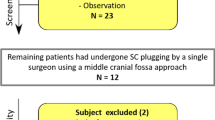Abstract
The purpose of this study was to compare the ability of T2-weighted three-dimensional turbo spin-echo (TSE) images, maximum intensity projections and three-dimensional volume-rendered images for delineation of semicircular canal dehiscence. In 26 patients with dehiscence of the superior and/or posterior semicircular canal and 26 control patients, TSE images were obtained with two different resolutions and maximum intensity projection (MIP) and 3D volume-rendered images reconstructed. All images were evaluated by two radiologists in consensus regarding the visualization of anatomical structures and dehiscence of the semicircular canals. Computed tomography was used to confirm or exclude dehiscence. Dehiscence of the semicircular canals was delineated on axial MR images and on 3D volume-rendered images, but not on MIP images. The number of false positive cases was reduced from 3 to 0 with an increase in matrix, rendering results similar to those obtained with CT. Dehiscence of the semicircular canals can be assessed on high resolution MR images. Volume-rendered 3D images allow for immediate perception of the location of defects in semicircular canal dehiscence. These images may facilitate understanding of the extent and location of the defects.



Similar content being viewed by others
References
Minor LB, Solomon D, Zinreich JS, Zee DS (1998) Sound- and/or pressure-induced vertigo due to bone dehiscence of the superior semicircular canal. Arch Otolaryngol Head Neck Surg 124:249–258
Williamson RA, Vrabec JT, Coker NJ, Sandlin M (2003) Coronal computed tomography prevalence of superior semicircular canal dehiscence. Otolaryngol Head Neck Surg 129:481–489
Halmagyi GM, Aw ST, McGarvie LA, et al (2003) Superior semicircular canal dehiscence simulating otosclerosis. J Laryngol Otol 117:553–557
Halmagyi GM, McGarvie LA, Aw ST, Yavor RA, Todd MJ (2003) The click-evoked vestibulo-ocular reflex in superior semicircular canal dehiscence. Neurology 60:1172–1175
Tsunoda A, Terasaki O (2002) Dehiscence of the bony roof of the superior semicircular canal in the middle cranial fossa. J Laryngol Otol 116:514–518
Hamid MA (2001) Bilateral dehiscence of the superior semicircular canals. Otol Neurotol 22:567–568
Ostrowski VB, Byskosh A, Hain TC (2001) Tullio phenomenon with dehiscence of the superior semicircular canal. Otol Neurotol 22:61–65
Brantberg K, Bergenius J, Mendel L, Witt H, Tribukait A, Ygge J (2001) Symptoms, findings and treatment in patients with dehiscence of the superior semicircular canal. Acta Otolaryngol 121:68–75
Mong A, Loevner LA, Solomon D, Bigelow DC (1999) Sound- and pressure-induced vertigo associated with dehiscence of the roof of the superior semicircular canal. AJNR Am J Neuroradiol 20:1973–1975
Brantberg K, Bergenius J, Tribukait A (1999) Vestibular-evoked myogenic potentials in patients with dehiscence of the superior semicircular canal. Acta Otolaryngol 119:633–640
Smullen JL, Andrist EC, Gianoli GJ (1999) Superior semicircular canal dehiscence: a new cause of vertigo. J La State Med Soc 151:397–400
Agrawal SK, Parnes LS (2001) Human experience with canal plugging. Ann N Y Acad Sci 942:300–305
Hirvonen TP, Carey JP, Liang CJ, Minor LB (2001) Superior canal dehiscence: mechanisms of pressure sensitivity in a chinchilla model. Arch Otolaryngol Head Neck Surg 127:1331–1336
Cremer PD, Minor LB, Carey JP, Della Santina CC (2000) Eye movements in patients with superior canal dehiscence syndrome align with the abnormal canal. Neurology 55:1833–1841
Carey JP, Minor LB, Nager GT (2000) Dehiscence or thinning of bone overlying the superior semicircular canal in a temporal bone survey. Arch Otolaryngol Head Neck Surg 126:137–147
Belden CJ, Weg N, Minor LB, Zinreich SJ (2003) CT evaluation of bone dehiscence of the superior semicircular canal as a cause of sound- and/or pressure-induced vertigo. Radiology 226:337–343
Curtin HD (2003) Superior semicircular canal dehiscence syndrome and multi-detector row CT. Radiology 226:312–314
Fox EJ, Balkany TJ, Arenberg IK (1988) The Tullio phenomenon and perilymph fistula. Otolaryngol Head Neck Surg 98:88–89
Minor LB (2003) Labyrinthine fistulae: pathobiology and management. Curr Opin Otolaryngol Head Neck Surg 11:340–346
Arnold B, Jager L, Grevers G (1996) Visualization of inner ear structures by three-dimensional high-resolution magnetic resonance imaging. Am J Otol 17:480–485
Casselman JW, Kuhweide R, Deimling M, Ampe W, Dehaene I, Meeus L (1993) Constructive interference in steady state-3DFT MR imaging of the inner ear and cerebellopontine angle. AJNR Am J Neuroradiol 14:47–57
Czerny C, Rand T, Gstoettner W, Woelfl G, Imhof H, Trattnig S (1998) MR imaging of the inner ear and cerebellopontine angle: comparison of three-dimensional and two-dimensional sequences. AJR Am J Roentgenol 170:791–796
Hans P, Grant AJ, Laitt RD, Ramsden RT, Kassner A, Jackson A (1999) Comparison of three-dimensional visualization techniques for depicting the scala vestibuli and scala tympani of the cochlea by using high-resolution MR imaging. AJNR Am J Neuroradiol 20:1197–1206
Klingebiel R, Thieme N, Kivelitz D, Enzweiler C, Werbs M, Lehmann R (2002) Three-dimensional imaging of the inner ear by volume-rendered reconstructions of magnetic resonance data. Arch Otolaryngol Head Neck Surg 128:549–553
Kosling S, Juttemann S, Amaya B, Rasinski C, Bloching M, Konig E (2003) [The role of MRI in suspected inner ear malformations]. Rofo 175:1639–1646
Acknowledgement
We thank Sven Stanzel, MSc, of the Institute of Medical Statistics, University of Technology, Aachen, for statistical assistance.
Author information
Authors and Affiliations
Corresponding author
Rights and permissions
About this article
Cite this article
Krombach, G.A., Di Martino, E., Martiny, S. et al. Dehiscence of the superior and/or posterior semicircular canal: delineation on T2-weighted axial three-dimensional turbo spin-echo images, maximum intensity projections and volume-rendered images. Eur Arch Otorhinolaryngol 263, 111–117 (2006). https://doi.org/10.1007/s00405-005-0970-x
Received:
Accepted:
Published:
Issue Date:
DOI: https://doi.org/10.1007/s00405-005-0970-x




